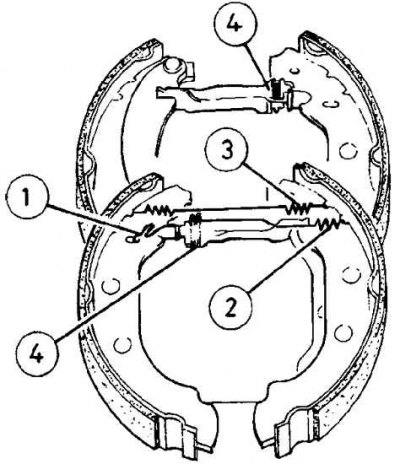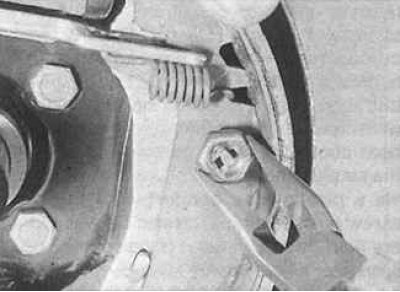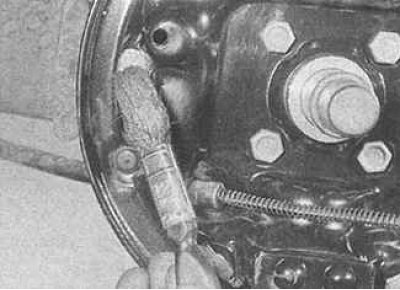Arrangement of elements of adjustment of brake pads

1. Regulator bolt fixing spring; 2. Regulator bar spring; 3. Upper return spring; 4. Adjusting element
Attention! Be sure to replace all the pads on one axle of the car, even if one pad has reached the wear limit. If the pads will be reinstalled, mark them before removing them.
1. Remove the brake drum.
2. Using care and safety measures, clean all traces of brake dust from the brake drum, brake shield and pads.
3. Measure the thickness of the brake pads at several points. If at least one pad is worn anywhere to the minimum thickness, replace all 4 brake pads.

4. Mark the installation position of all elements of the rear brake. Using pliers, remove the pad fixing spring plate by pressing the plate and turning it 90°. Remove springs and remove retainer pins.
5. Remove one brake shoe from the lower shoe support and disconnect the lower return spring.
6. Press both pads off the wheel brake cylinder and remove them. Do not damage the anthers while doing this. Disconnect the handbrake cable from the brake shoe. To prevent the pistons from falling out of the working brake cylinder, secure the pistons with an appropriate rubber band or wire.
7. Mark the location of the parts of the brake shoe adjuster, remove the handbrake lever and disconnect the adjuster bolt fixing spring from the front (by location) brake pad. Disconnect the upper return spring, separate the front brake shoe and return spring from the rear brake shoe. Disconnect the spring securing the adjuster to the rear brake shoe (see fig. Arrangement of elements of adjustment of brake pads).
8. Replace all return springs regardless of their condition.
9. Unscrew the bolt securing the regulator to the adjusting bar and check their condition. Pay special attention to the threads of the adjuster bolt and the edges of the adjusting wheel. Please note that the left and right shims are not interchangeable. The right and left wheel adjuster bolts are also not interchangeable. The left wheel adjuster bolt has a left hand thread and the right wheel adjuster bolt has a right hand thread.
10. Check that all parts at the end of the adjuster bar are properly seated, then apply a small amount of high melting point grease to the threads of the adjuster bolt. Thread the adjusting wheel onto the adjuster bolt until there is a slight gap between the adjuster wheel and the bolt head. Insert the adjuster bolt into the adjustment bar.
11. Install the return spring on the rear (by location) brake shoe in such a way that the shorter hook of the spring connects to the shoe. Install the adjusting bar to the end of the spring. Insert the adjusting bar into the groove in the rear brake shoe.
12. Install the upper return spring to the rear brake shoe. Install the other end of the spring on the front brake shoe and, moving, position the front shoe so that the head of the adjusting bolt is located in the groove. After that, insert the hook of the fixing spring into the groove on the front brake shoe.
13. Raise the rubber protective boots of the brake cylinder and check the working brake cylinder for brake fluid leaks.

14. Clean the rear brake parts. Apply a lubricant with a high melting point to the contact points of the brake pads with the brake shield.
15. Check that the handbrake lever is located against the edge of the rear brake shoe, and remove the rubber band that secures the pistons in the brake cylinder.
16. Stretch the brake shoes and install their upper ends on the piston of the working brake cylinder. Connect the handbrake cable to the handbrake lever located on the rear brake shoe. Install the bottom return spring on both brake shoes, install the bottom of the brake shoes on the shoe support.
17. When moving the brake pads, center them in relation to the brake shield. Install the pad retainer pins, springs and spring retainer plate.
18. Using a screwdriver, turn the adjusting bar wheel so that the brake pads are unclenched until they touch the brake drum.
19. Install the brake drum.
20. Replace the brake pads on the second rear wheel.
21. After replacing the brake pads, adjust the clearance between them and the brake drum by depressing the brake pedal several times. When you press the pedal during normal operation of the adjusting bar, you should hear clicks emitted by the adjusting bar.
22. Check and, if necessary, adjust the handbrake.
23. Check the brake fluid level in the system.
